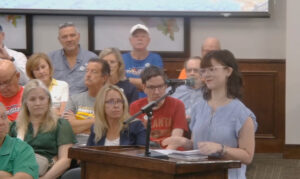After hearing details of a potential dredging project at Lake Peachtree beyond the scope of the upcoming work by Fayette County, the Peachtree City Council on Nov. 6 agreed to have the item placed on the Nov. 20 agenda to discuss possible remedies.
The cost of dredging could run from $400,000 to $1.35 million, though county representative Lee Pope suggested that the cost could be less if the city were to piggy-back on the county’s dredging proposal.
Some residents at the meeting called for the city’s dredging project to be put into action while others suggested a different approach which could include leaving things as they are now since the vegetation will die off during the winter and will be covered by the water when the lake level is restored.
Mayor Vanesa Fleisch noted that the dredging project is not funded, while Councilman Eric Imker suggested that other ways could be sought to pay the expense. An example of that, said Imker, would be a 20-year bond based on a $2 million project that would cost taxpayers $10 per year over 20 years.
While options exist, Councilwoman Kim Learnard echoed the thoughts of others on the council, saying that “the issue needs to be addressed now.”
A study done by Integrated Science and Engineering (ISE) noted other areas of the lake where silt had accumulated over the years. City Manager Jim Pennington said that while occasional discussions had been held over the past two years about ways to address the issue, he felt it was time to revisit it.
The timing comes as the county is preparing to dredge a large area immediately south of Ga. Highway 54 and several smaller areas primarily on the west side of the lake.
Pennington also referenced the possibility of the city appending itself to the county’s contract and dredging other areas of the lake which have experienced silting and a reduction of depth.
County Administrator Steve Rapson in an Oct. 24 letter said the county’s dredging project remains on schedule, with the letting of the actual dredging bid scheduled near the end of December and with the first dirt to be removed in January.
The additional areas identified for possible dredging which lie outside the area to be dredged by the county carry estimated cost of $400,000 to $1.35 million based on a price of $30-50 per cubic yard.
Those areas include sections on the east and west sides of the lake and the area immediately south of the large section to be dredged by the county.
ISE representative Dan Davis cautioned that, beyond those potential expenses, actual costs could vary significantly and would have to take into account issues such as haul routes, damage to city infrastructure from truck loads, disposal sites and environmental permitting.
Davis said surveyors were also asked to assess the island near Battery Way Park which was apparently formed when the lake was dredged prior to 1993.
The estimated cost if the island were removed would be $2.925-4.875 million.
The reason for a potential decision on the issue, aside from piggy-backing on the county’s bid, is that word is expected on the outcome of the appeal on the state’s decision to have the dam labeled at Category 1 dam rather than a Category 2. A Category 1 dam would require significantly more money to construct.
Davis in his comments noted that the lake and the spillway are half a century old.











Leave a Comment
You must be logged in to post a comment.